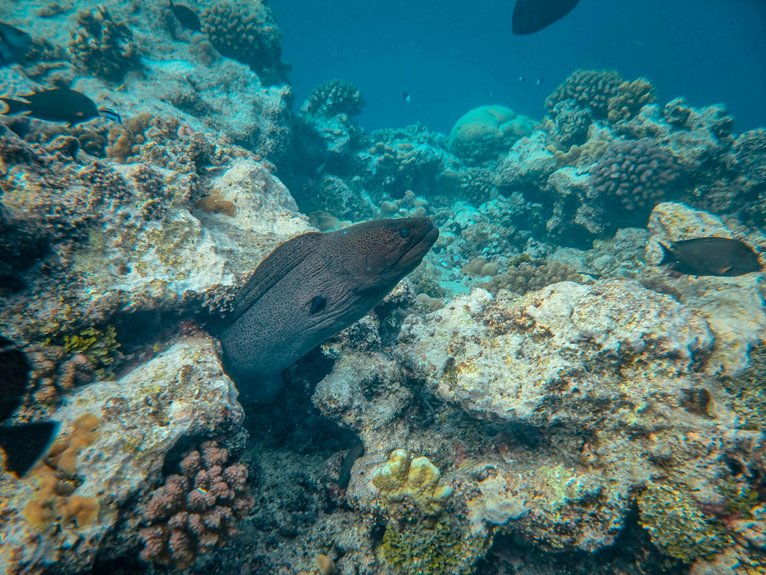Dive sites like Tulamben’s Liberty Wreck, Tortola’s Blue Water Divers, and Bonaire’s reefs are hotspots for moray eel colonies. The Liberty Wreck hosts garden eels swaying in currents, while nearby Coral Garden offers views of ribbon eels in crevices. In Tortola, Santa Monica Rock is a haven for giant moray eels, and Bonaire’s reefs showcase spotted morays as apex predators. Mexican sites near La Paz feature jeweled morays hunting alongside sea lions. Explore these locations to witness their unique behaviors and habitats up close.
Key Takeaways
- Blue Water Divers in Tortola, BVI, offer dives at Santa Monica Rock, a key habitat for moray eels amidst rocky reefs with excellent visibility.
- Bonaire’s coral reefs are home to Spotted Moray Eels, active during night dives and easily observable at depths of 70-90 feet.
- Mexican dive sites near La Paz feature Jeweled Moray Eels, often seen hunting near reefs and sea lion colonies in shallow waters.
- Ras Mohammed in Egypt’s Red Sea is renowned for its vibrant reefs teeming with moray eels, accessible to divers of all experience levels.
- Norman Island’s Santa Monica Rock provides ample habitat for moray eels, with clear waters making it easy to spot these fascinating creatures.
Liberty Wreck in Tulamben: Home to Garden Eel Colonies
Exploring the Liberty Wreck in Tulamben, you’ll discover a fascinating underwater spectacle: a vibrant colony of garden eels thriving in the shallow, sandy areas surrounding the wreck. These eels, often mistaken for underwater grass, sway collectively in the current, creating a mesmerizing display. Garden eels are filter feeders, using their elongated snouts to capture tiny plankton drifting in the water. When disturbed, they retreat rapidly into their burrows in the sandy substrate, vanishing in an instant. The Liberty Wreck is renowned for its exceptional visibility and access to these unique creatures. Unlike Cyrus diving sites, where moray eels often dominate, this location highlights garden eels as the main attraction. Their communal behavior and abundance make it a prime spot for divers to observe their social dynamics. The wreck’s ecosystem supports a thriving habitat, showcasing the adaptability of these eels in their shallow, sandy environment.
Coral Garden in Tulamben: Spotting Ribbon Eels
The Coral Garden in Tulamben stands out as a premier destination for encountering ribbon eels. Known for their striking appearance, these morays are born male and undergo a dramatic transformation from yellow juveniles to black adults. Their slender bodies and ribbon-like dorsal fins make them a unique sight. Ribbon eels are rarely seen swimming freely, preferring to hide in sandy crevices or holes, where they can ambush prey.
| Characteristic | Description |
|---|---|
| Juvenile Color | Bright yellow, transforming to black as they mature. |
| Body Shape | Long, thin bodies with ribbon-like dorsal fins. |
| Behavior | Rarely swim freely; prefer hiding in sand holes or crevices. |
| Appearance | Protruding nostrils give them a dragon-like resemblance. |
This site offers divers a chance to observe these fascinating creatures up close, making it a must-visit for marine enthusiasts.
Blue Water Divers in Tortola, BVI:Moray Eel Habitats
Imagine diving into the crystal-clear waters of Santa Monica Rock in Norman Island, where the seafloor, covered in sparkling sand, teems with moray eels. This site, frequented by Blue Water Divers in Tortola, BVI, offers a unique opportunity to observe these fascinating creatures in their natural habitat. The rocky formations and reefs surrounding Santa Monica Rock provide ample hiding spots for moray eels, which often gather in colonies. Divers can expect to see species like the giant moray eel, their sleek bodies undulating as they navigate through crevices and caverns. The area’s underwater topography, characterized by steep drop-offs and coral-encrusted boulders, creates a dynamic environment where morays thrive. Visibility often exceeds 80 feet, allowing divers to effortlessly spot these eels as they hunt or interact. With moderate currents, Santa Monica Rock is an ideal location for both novice and experienced divers to explore the intriguing world of moray eel colonies.
Bonaire Dive Sites: Spotted Moray Eel Colonies
Dive sites in Bonaire offer a unique opportunity to encounter Spotted Moray Eels in their natural habitat. These eels, which can grow up to 7 feet, are commonly found in the Western Atlantic and Caribbean waters. They primarily inhabit coral reefs, and while specific dive sites aren’t detailed, they thrive in Bonaire’s vibrant marine ecosystem. Spotted Moray Eels are typically active during night dives, often observed at depths of 70-90 feet. Footage from these dives shows their nocturnal hunting behavior, such as one individual capturing a Damselfish. This highlights their role as apex predators in Bonaire’s reefs. The island’s dive sites provide exceptional opportunities to witness these eels in action, contributing to its reputation for rich marine biodiversity. Exploring Bonaire’s reefs allows you to experience the fascinating behavior of Spotted Moray Eels firsthand.
Mexican Dive Sites: Jeweled Moray Eel Encounters
Mexico’s vibrant dive sites, particularly around La Paz, invite you to witness Jeweled Moray Eels flourishing amidst a dynamic sea lion colony as they actively hunt in reef holes. These eels, known for their striking appearance,can be observed during the morning hours, showcasing their efficiency as predators. They typically capture prey within minutes, demonstrating their adaptability and speed. Dive sites in this region offer ideal conditions, with depths ranging from 40 to 50 feet, allowing divers to explore the eels’ natural habitat. While primarily nocturnal, Jeweled Moray Eels in Mexican waters can also be active during the day, providing unique opportunities for observation. Their diet, which includes fish, crustaceans, and smaller eels, highlights their role as apex predators. This location offers a rare chance to observe these creatures in their element, blending seamlessly with the lively sea lion colony and coral reefs.
Frequently Asked Questions
Where Are Moray Eels Commonly Found?
You’ll find moray eels throughout tropical and subtropical waters. They’re common in the Western Atlantic, including the Gulf of Mexico and Caribbean, and the Eastern Pacific, from the Gulf of California to Central America. In the Indo-Pacific, species like giant morays and ribbon eels thrive, especially in locations such as Tulamben, Bali. They’re also abundant around Bonaire, French Cay, and the Turks and Caicos Islands, with populations extending to mid- and eastern Atlantic islands like St. Helena.
What Layer of the Ocean Do Moray Eels Live In?
Moray eels primarily inhabit the benthic layer, often in cracks and crevices near reefs. They’re also found in the demersal layer in deeper waters, associating with underwater structures. Garden eels burrow in sandy sediments in the infralittoral zone, while ribbon eels occupy both layers depending on their life stage. They thrive from shallow waters to depths of up to 660 feet, adapting to various environments with depth-dependent behaviors, showcasing their versatility across ocean zones.
Are Moray Eels in the Great Barrier Reef?
Yes, moray eels are found in the Great Barrier Reef, though they are less abundant compared to other global locations like the Caribbean. Species such as ribbon eels inhabit specific sites, including the Monolith Dive Site on Ribbon Reef No. 10 near Cairns. They thrive in coral walls, bommies, and sandy areas, often in deeper reefs. These eels hunt small fish and crustaceans, contributing to the diverse marine biodiversity of the region.
What Are the Special Features of the Moray Eel?
You’re exploring the unique traits of moray eels. These eels can grow up to 10 feet long, making them among the largest. They’re nocturnal predators, hunting at night while resting in crevices during the day. Morays have a second set of jaws in their throat to grasp prey, aiding digestion. They thrive in diverse environments, from shallow waters to depths of 660 feet. Some species, like ribbon eels, undergo colorful transformations as they mature, adding to their intrigue.
Conclusion
Exploring these dive sites offers unforgettable encounters with moray eel colonies. At the Liberty Wreck in Tulamben, witness thousands of garden eels swaying in unison, a sight few divers ever experience. Coral Garden’s ribbon eels, with their striking yellow and black stripes, add vibrant color to the reef. Blue Water Divers in Tortola, BVI, and Bonaire’s coral reefs are hotspots for spotted morays, while Mexico’s reefs teem with jeweled morays. Did you know some colonies can number over a hundred individuals?

Meet Natalie, who has lived on Cyprus for the last 10 years. She loves exploring the beautiful nature of the island, like quiet forests and untouched beaches. Natalie has lots of cool experiences to share. Join her as she talks about her adventures in Cyprus.

